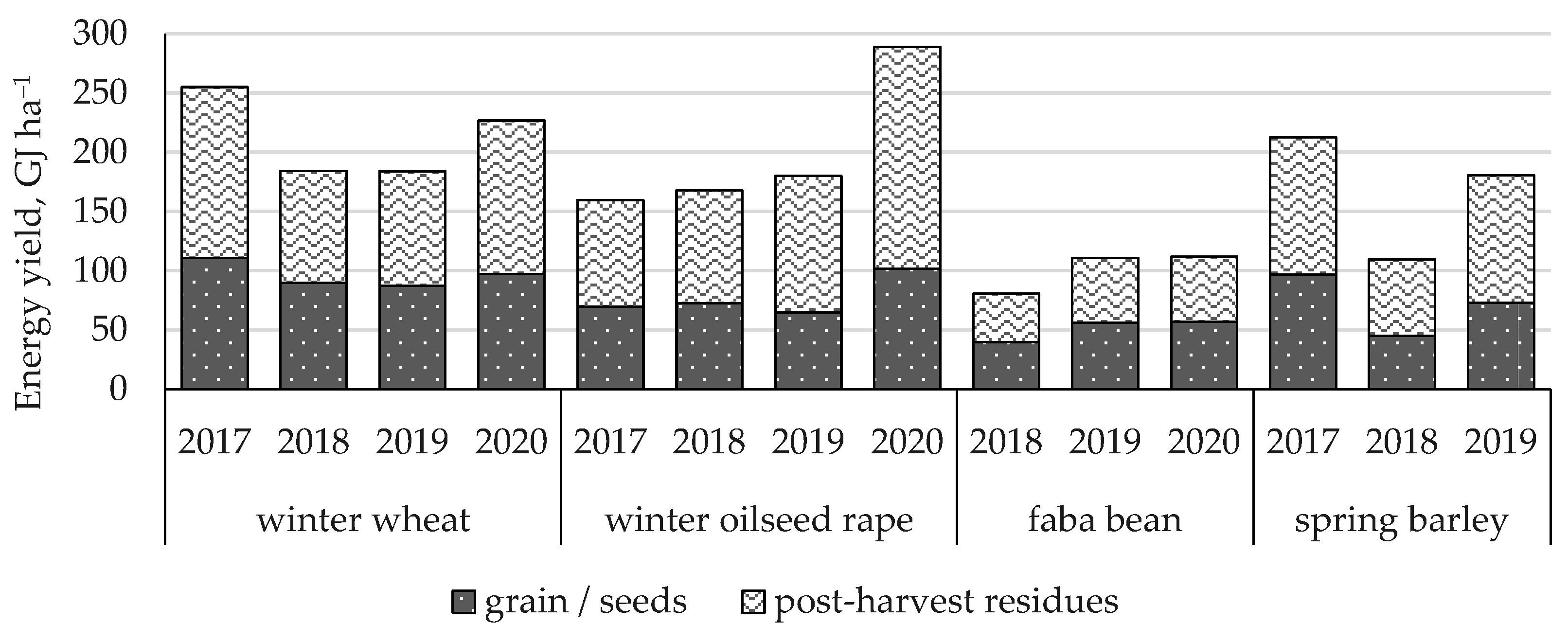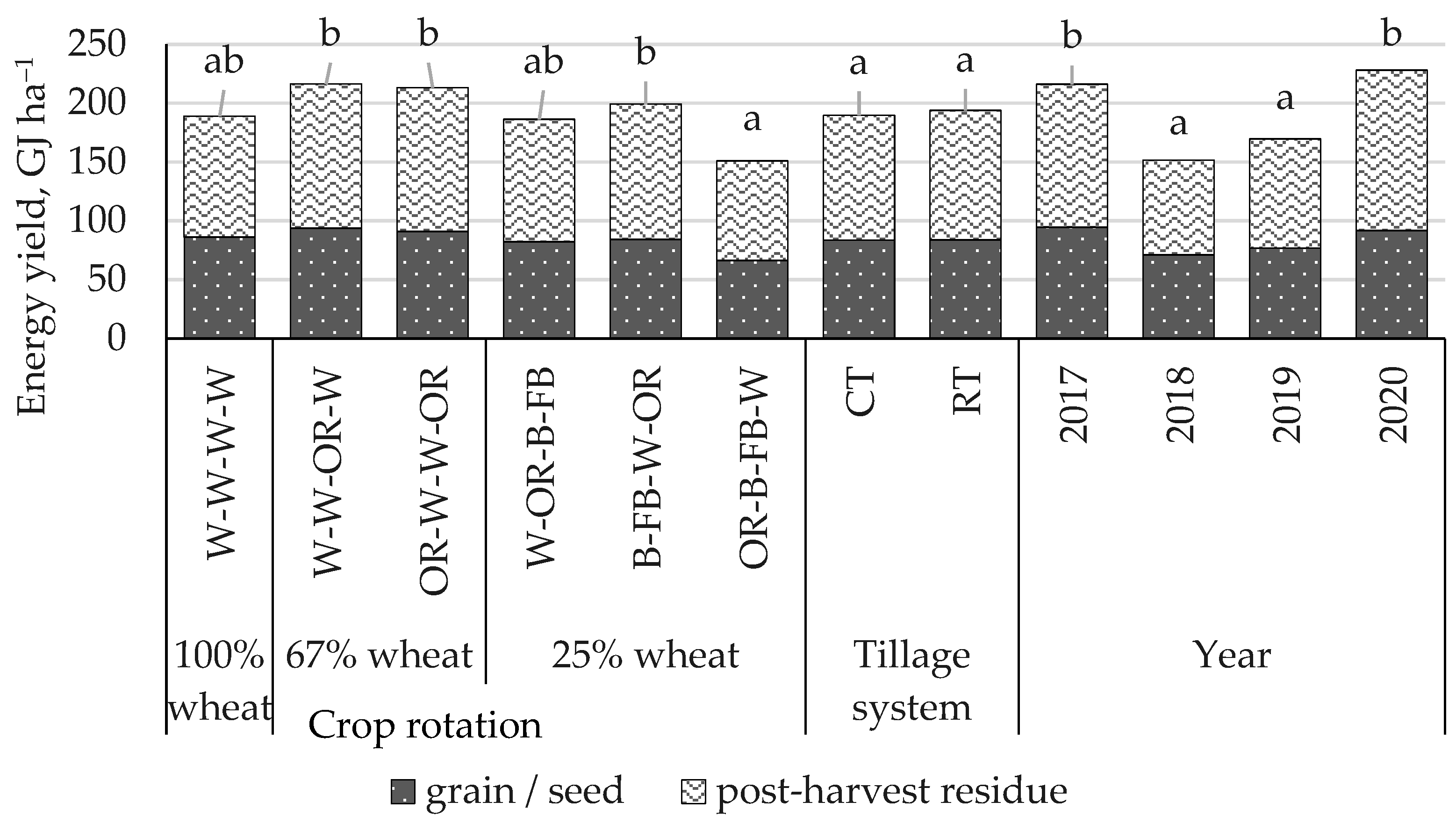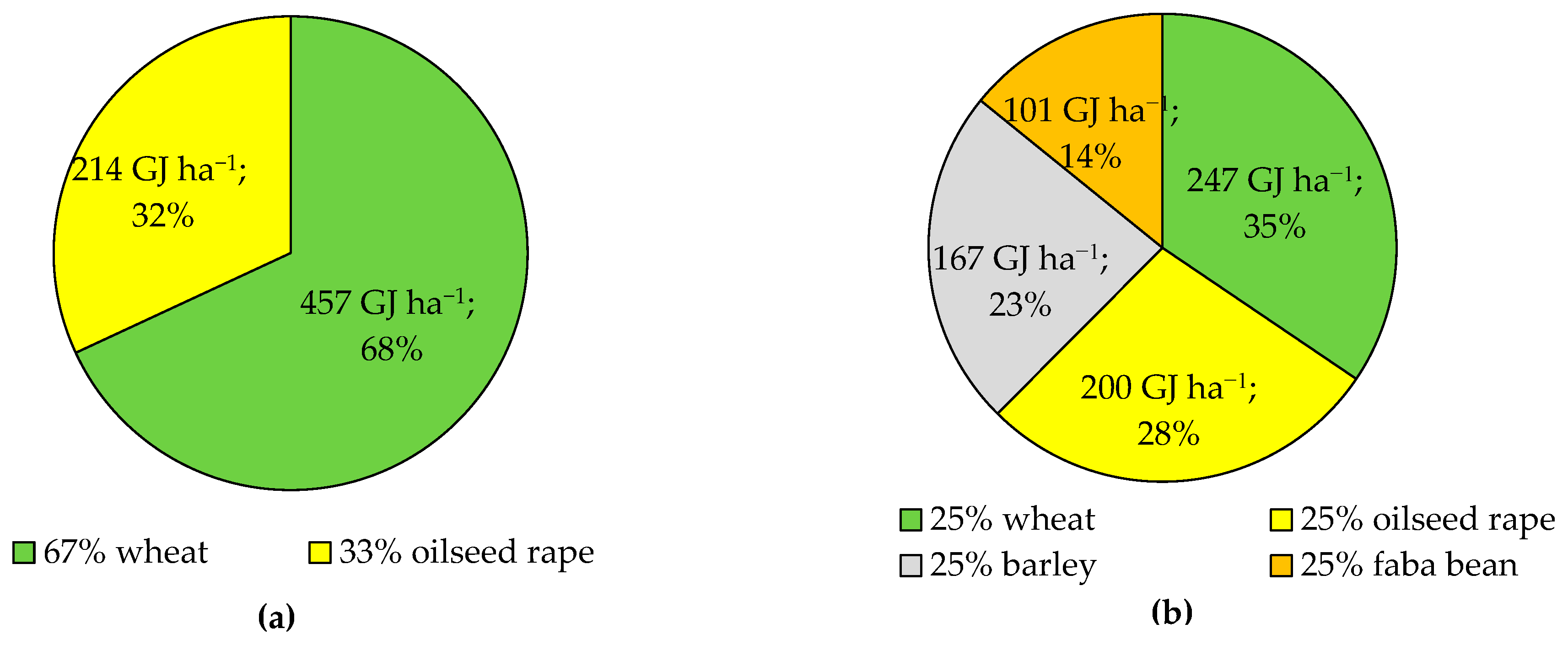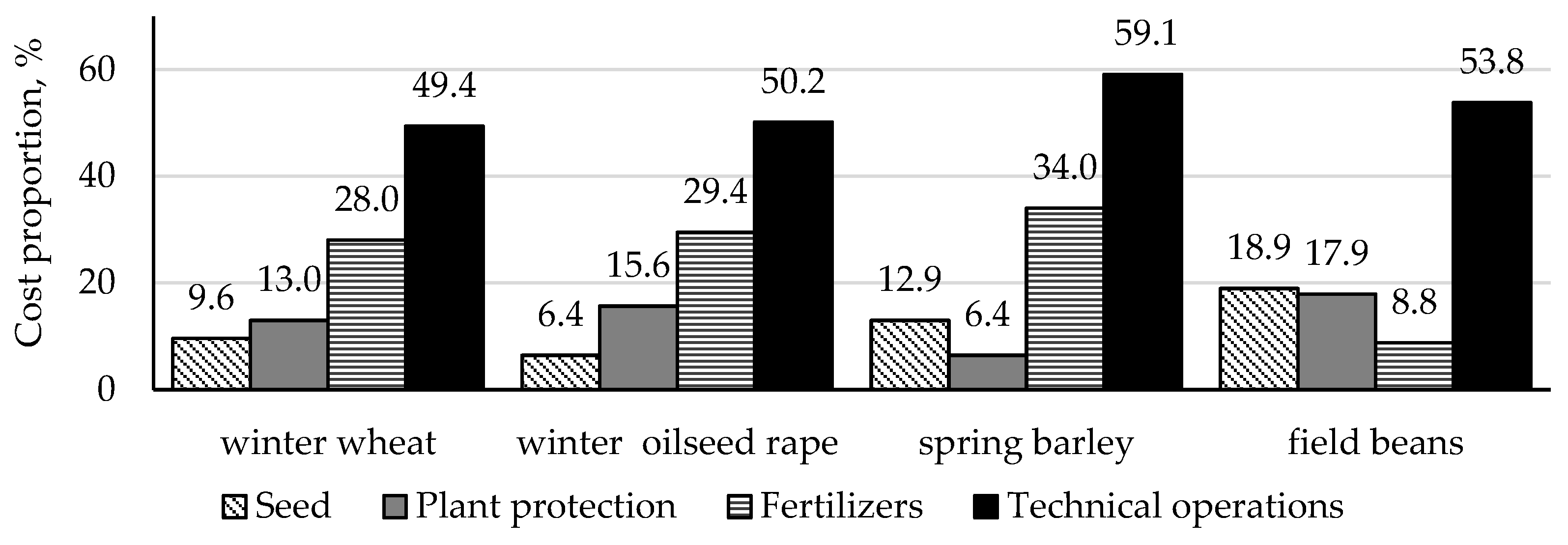The Productivity of Crop Rotation Depending on the Included Plants and Soil Tillage
Abstract
:1. Introduction
2. Materials and Methods
2.1. General Information about the Trial
- Conventional tillage system (CT) with mould-board ploughing at a depth to 24 cm;
- Reduced tillage system (RT) with soil disc harrowing at a depth to 10 cm.
- Repeated winter wheat (Triticum aestivum) rotation (W–W; 100% wheat);
- Three-year rotation with oilseed rape (Brassica napus ssp. oleifera) and two years of winter wheat (OR–W–W; 67% wheat);
- Four year rotation with four different crops in rotation (sequence: field bean (Vicia faba)–winter wheat–oilseed rape–spring barley (Hordeum vulgare) (FB–W–OR–B; wheat proportion in rotation—25%)).
2.2. Yield
2.3. Energy Yield
2.4. Economic Profitability
2.5. Mathematical Data Processing
2.6. Meteorological Conditions during the Study Period
3. Results
3.1. Wheat Grain and Straw Yield
3.2. Oilseed Rape, Barley and Field Bean Seed and Straw Yield
3.3. Energy Yield
3.4. Economic Assessment
4. Discussion
5. Conclusions
Author Contributions
Funding
Institutional Review Board Statement
Data Availability Statement
Conflicts of Interest
References
- Renard, D.; Tilman, D. National food production stabilized by crop diversity. Nature 2019, 571, 257–260. [Google Scholar] [CrossRef]
- Revoyron, E.; Le Bail, M.; Meynard, J.-M.; Gunnarsson, A.; Seghetti, M.; Colombo, L. Diversity and drivers of crop diversification pathways of European farms. Agric. Syst. 2022, 201, 103439. [Google Scholar] [CrossRef]
- FAOStat, Value of Agricultural Production. Available online: https://www.fao.org/faostat/en/#data/QV (accessed on 3 July 2023).
- Zörb, C.; Geilfus, C.-M.; Dietz, K.-J. Salinity and crop yield. Plant Biol. 2019, 21 (Suppl. 1), 31–38. [Google Scholar] [CrossRef] [PubMed]
- Aguilar, J.; Gramig, G.G.; Hendrickson, J.R.; Archer, D.W.; Forcella, F.; Liebig, M.A. Crop Species Diversity Changes in the United States: 1978–2012. PLoS ONE 2015, 10, e0136580. [Google Scholar] [CrossRef]
- Beillouin, D.; Ben-Ari, T.; Malézieux, E.; Seufert, V.; Makowski, D. Positive but variable effects of crop diversification on biodiversity and ecosystem services. Glob. Chang. Biol. 2021, 27, 4697–4710. [Google Scholar] [CrossRef] [PubMed]
- Reckling, M.; Döring, T.F.; Bergkvist, G.; Stoddard, F.L.; Watson, C.A.; Seddig, S.; Chmielewski, F.-M.; Bachinger, J. Grain legume yields are as stable as other spring crops in long-term experiments across northern Europe. Agron. Sustain. Dev. 2018, 38, 63. [Google Scholar] [CrossRef] [PubMed]
- Raseduzzaman; Jensen, E.S. Does intercropping enhance yield stability in arable crop production? A meta-analysis. Eur. J. Agron. 2017, 91, 25–33. [Google Scholar] [CrossRef]
- Ločmele, I.; Legzdiņa, L.; Gaile, Z.; Kronberga, A. Estimation of yield and yield stability of spring barley genotype mixtures. In Proceedings of the Research for Rural Development, 2, 19–25, Jelgava, Latvia, 17–19 May 2017. [Google Scholar] [CrossRef]
- Ghorbani, R.; Mondani, F.; Amirmoradi, S.; Feizi, H.; Khorramdel, S.; Teimouri, M.; Sanjani, S.; Anvarkhah, S.; Aghel, H. A case study of energy use and economical analysis of irrigated and dryland wheat production systems. Appl. Energy 2011, 88, 283–288. [Google Scholar] [CrossRef]
- Dimitrijević, A.; Gavrilović, M.; Ivanović, S.; Mileusnić, Z.; Miodragović, R.; Todorović, S. Energy Use and Economic Analysis of Fertilizer Use in Wheat and Sugar Beet Production in Serbia. Energies 2020, 13, 2361. [Google Scholar] [CrossRef]
- Xing, H.; Liu, D.L.; Li, G.; Wang, B.; Anwar, M.R.; Crean, J.; Lines-Kelly, R.; Yu, Q. Incorporating grain legumes in cereal-based cropping systems to improve profitability in southern New South Wales, Australia. Agric. Syst. 2017, 154, 112–123. [Google Scholar] [CrossRef]
- MacWilliam, S.; Wismer, M.; Kulshreshtha, S. Life cycle and economic assessment of Western Canadian pulse systems: The inclusion of pulses in crop rotations. Agric. Syst. 2014, 123, 43–53. [Google Scholar] [CrossRef]
- Wieme, R.A.; Carpenter-Boggs, L.A.; Crowder, D.W.; Murphy, K.M.; Reganold, J.P. Agronomic and economic performance of organic forage, quinoa, and grain crop rotations in the Palouse region of the Pacific Northwest, USA. Agric. Syst. 2020, 177, 102709. [Google Scholar] [CrossRef]
- Cortignani, R.; Dono, G. Greening and legume-supported crop rotations: An impacts assessment on Italian arable farms. Sci. Total Environ. 2020, 734, 139464. [Google Scholar] [CrossRef] [PubMed]
- Reckling, M.; Bergkvist, G.; Watson, C.A.; Stoddard, F.L.; Zander, P.M.; Walker, R.L.; Pristeri, A.; Toncea, I.; Bachinger, J. Trade-Offs between Economic and Environmental Impacts of Introducing Legumes into Cropping Systems. Front. Plant Sci. 2016, 7, 669. [Google Scholar] [CrossRef]
- Lötjönen, S.; Ollikainen, M. Does crop rotation with legumes provide an efficient means to reduce nutrient loads and GHG emissions? Rev. Agric. Food Environ. Stud. 2017, 98, 283–312. [Google Scholar] [CrossRef]
- Romaneckas, K.; Avižienytė, D.; Adamavičienė, A.; Bogužas, V.; Sinkevičienė, A.; Šarauskis, E.; Jasinskas, A.; Kimbirauskienė, R.; Balandaitė, J.; Minajeva, A.; et al. Impact of reduced tillage on spring oil seed rape, winter wheat, maize and barley production in Lithuania. In Proceedings of the 47th Symposium ”Actual Tasks on Agricultural Engineering”, Opatija, Croatia, 21–24 February 2019; pp. 61–67. [Google Scholar]
- Darguza, M.; Gaile, Z. Productivity of crop rotation measured as energy produced by included plants: A review. In Proceedings of the Annual 24th International Scientific Conference “Research for Rural Development 2018”, Jelgava, Latvia, 16–18 May 2018; Volume 2, pp. 20–27. [Google Scholar] [CrossRef]
- Alluvione, F.; Moretti, B.; Sacco, D.; Grignani, C. EUE (energy use efficiency) of cropping systems for a sustainable agriculture. Energy 2011, 36, 4468–4481. [Google Scholar] [CrossRef]
- Zhang, L.; Xu, C.C.; Champagne, P. Overview of recent advances in thermo-chemical conversion of biomass. Energy Convers. Manag. 2010, 51, 969–982. [Google Scholar] [CrossRef]
- Erol, M.; Haykiri-Acma, H.; Küçükbayrak, S. Calorific value estimation of biomass from their proximate analyses data. Renew. Energy 2010, 35, 170–173. [Google Scholar] [CrossRef]
- Dai, J.; Bean, B.; Brown, B.; Bruening, W.; Edwards, J.; Flowers, M.; Karow, R.; Lee, C.; Morgan, G.; Ottman, M.; et al. Harvest index and straw yield of five classes of wheat. Biomass Bioenergy 2016, 85, 223–227. [Google Scholar] [CrossRef]
- Zentner, R.; Lafond, G.; Derksen, D.; Nagy, C.; Wall, D.; May, W. Effects of tillage method and crop rotation on non-renewable energy use efficiency for a thin Black Chernozem in the Canadian Prairies. Soil Tillage Res. 2004, 77, 125–136. [Google Scholar] [CrossRef]
- Karklins, A. Soil organic carbon content and stock depending on used soil tillage methods. In Proceedings of the Connecting People and Soil, Geneva, Switzerland, 23–27 August 2021. [Google Scholar]
- Gross Coverage Calculation for 2017, Latvian Rural Advisory and Training Center. Available online: https://new.llkc.lv/lv/nozares/augkopiba-ekonomika-lopkopiba/sagatavoti-bruto-segumi-par-2017-gadu (accessed on 3 July 2023).
- Gross Coverage Calculation for 2018, Latvian Rural Advisory and Training Center. Available online: https://new.llkc.lv/lv/nozares/augkopiba-ekonomika-lopkopiba/sagatavoti-bruto-segumi-par-2018-gadu (accessed on 3 July 2023).
- Gross Coverage Calculation for 2019, Latvian Rural Advisory and Training Center. Available online: https://new.llkc.lv/lv/nozares/augkopiba-ekonomika-lopkopiba/sagatavoti-bruto-segumi-par-2019-gadu (accessed on 3 July 2023).
- Gross Coverage Calculation for 2020, Latvian Rural Advisory and Training Center. Available online: https://new.llkc.lv/lv/nozares/augkopiba-ekonomika-lopkopiba/sagatavoti-bruto-segumi-par-2020-gadu (accessed on 3 July 2023).
- Gross Coverage Calculation for 2016, Latvian Rural Advisory and Training Center. Available online: https://new.llkc.lv/lv/nozares/ekonomika/sagatavoti-bruto-segumi-par-2016-gadu (accessed on 3 July 2023).
- Macholdt, J.; Piepho, H.P.; Honermeier, B.; Perryman, S.; Macdonald, A.; Poulton, P. The effect of cropping sequence, fertilization and straw management on the yield stability of winter wheat (1986–2017) in the Broadbalk wheat experiment, Rothamsted, UK. J. Agric. Sci. 2020, 58, 65–79. [Google Scholar] [CrossRef]
- Pszczółkowska, A.; Okorski, A.; Olszewski, J.; Fordoński, G.; Krzebietke, S.; Chareńska, A. Effects of pre-preceding leguminous crops on yield and chemical composition of winter wheat grain. Plant Soil Environ. 2018, 64, 592–596. [Google Scholar] [CrossRef]
- Vrtilek, P.; Smutny, V.; Dryšlova, T.; Neudert, L.; Kren, J. The effect of agronomic measures on grain yield of winter wheat in drier conditions. Plant Soil Environ. 2019, 65, 63–70. [Google Scholar] [CrossRef]
- Gawęda, D.; Haliniarz, M. Grain Yield and Quality of Winter Wheat Depending on Previous Crop and Tillage System. Agriculture 2021, 11, 133. [Google Scholar] [CrossRef]
- Pittelkow, C.M.; Linquist, B.A.; Lundy, M.E.; Liang, X.; van Groenigen, K.J.; Lee, J.; van Gestel, N.; Six, J.; Venterea, R.T.; van Kessel, C. When does no-till yield more? A global meta-analysis. Field Crop. Res. 2015, 183, 156–168. [Google Scholar] [CrossRef]
- Seibutis, V.; Deveikytė, I.; Feiza, V. Effects of short crop rotation and soil tillage on winter wheat development in central Lithuania. Agron. Res. 2009, 7, 471–476. [Google Scholar]
- Woźniak, A.; Rachoń, L. Effect of Tillage Systems on the Yield and Quality of Winter Wheat Grain and Soil Properties. Agriculture 2020, 10, 405. [Google Scholar] [CrossRef]
- Răus, L.; Jităreanu, G.; Ailincăi, C.; Pârvan, L.; Ţopa, D. Impact of different soil tillage systems and organo-mineral fertilization on physical properties of the soil ans on crops yiels in pedoclimatic conditions on Moldovian pedoclimatic condition of Moldovian plateau. Rom. Agric. Res. 2016, 33, 111–123. [Google Scholar]
- Hegewald, H.; Wensch-Dorendorf, M.; Sieling, K.; Christen, O. Impacts of break crops and crop rotations on oilseed rape productivity: A review. Eur. J. Agron. 2018, 101, 63–77. [Google Scholar] [CrossRef]
- Bennett, A.J.; Hilton, S.; Chandler, D.; Mills, P.; Bending, G.D. Relationships between yield, rotation length, and abundance of Olpidium brassicae and Pyrenochaeta sp. in the rhizosphere of oilseed rape. Appl. Soil Ecol. 2019, 147, 103433. [Google Scholar] [CrossRef]
- Šarauskis, E.; Romaneckas, K.; Jasinskas, A.; Kimbirauskienė, R.; Naujokienė, V. Improving energy efficiency and environmental mitigation through tillage management in faba bean production. Energy 2020, 209, 118453. [Google Scholar] [CrossRef]
- Malecka, I.; Blecharczyk, A.; Sawinska, Z.; Dobrzeniecki, T. The effect of various long-term tillage systems on soil properties and spring barley yield. Turk. J. Agric. For. 2012, 36, 217–226. [Google Scholar] [CrossRef]
- Nagy, C.N.; Jonhston, A.M.; Wall, D.D.; Zentner, R.P.; Gill, R. Influence of tillage method on non-renewable energy use efficiency in the black and gray soil zones in Regina. In Proceedings of the Climate Change Workshop, Saskatchewan Agriculture and Food, Saskatoon, SK, Canada, 11–12 December 2000. [Google Scholar]
- Kroģere, R.; Liepiņš, J.; Ausmane, M.; Melngalvis, I. Augsnes pamatapstrādes minimalizācija augsekā I Augsekas produk-tivitāte. LLU Raksti 2005, 13, 18–25. [Google Scholar]
- Strašil, Z.; Vach, M.; Smutný, V. The Energy Effectiveness Of Crops In Crop Rotation Under Different Soil Tillage Systems. Agriculture 2015, 61, 77–87. [Google Scholar] [CrossRef]
- Preissel, S.; Reckling, M.; Schläfke, N.; Zander, P. Magnitude and farm-economic value of grain legume pre-crop benefits in Europe: A review. Field Crops Res. 2015, 175, 64–79. [Google Scholar] [CrossRef]
- Weiser, C.; Fuß, R.; Kage, H.; Flessa, H. Do farmers in Germany exploit the potential yield and nitrogen benefits from preceding oilseed rape in winter wheat cultivation? Arch. Agron. Soil Sci. 2017, 64, 25–37. [Google Scholar] [CrossRef]
- Miljkovic, D.; Vatsa, P. On the linkages between energy and agricultural commodity prices: A dynamic time warping analysis. Int. Rev. Financ. Anal. 2023, 90, 102834. [Google Scholar] [CrossRef]
- Upite, I.; Bite, D.; Pilvere, I.; Nipers, A. Impacts of COVID-19 on the Food Supply Chain for Arable Crops in Latvia. Rural Sustain. Res. 2022, 47, 47–60. [Google Scholar] [CrossRef]





| Grain/Seed Type | 2017 | 2018 | 2019 | 2020 |
|---|---|---|---|---|
| Wheat grains, food | 152.00 | 185.00 | 162.00 | 169.00 |
| Wheat grains, feed | 134.00 | 175.00 | 144.00 | 151.00 |
| Oilseed rape seeds | 352.00 | 351.00 | 373.00 | 356.00 |
| Barley grains | 129.00 | 176.37 | 133.60 | 137.00 |
| Field bean seeds, feed | 200.00 | 225.00 | 225.00 | 220.00 |
| Year (Y) | Soil Tillage (ST) | Crop Rotation (CR) | Average, p < 0.001 | |||
|---|---|---|---|---|---|---|
| Conventional Tillage (CT) | Reduced Tillage (RT) | 100% Wheat | 67% Wheat | 25% Wheat | ||
| 2017 | 6.87 a | 7.48 b | 6.38 a | 7.08 a | 8.06 b | 7.17 B |
| 2018 | 6.24 a | 6.11 a | 5.23 a | 6.65 b | - | 6.18 A |
| 2019 | 5.70 a | 5.66 a | 4.93 a | 5.46 b | 6.64 c | 5.68 A |
| 2020 | 6.30 a | 6.16 a | 6.06 a | 6.22 ab | 6.41 b | 6.23 A |
| Average | 6.28 A | 6.35 A | 5.39 A | 6.40 B | 6.77 B | × |
| p-value | 0.33 | <0.001 | ||||
| Soil Tillage | Field Crop | ||
|---|---|---|---|
| Oilseed Rape | Spring Barley | Field Bean | |
| Conventional | 3.03 a | 4.50 a | 3.17 b |
| Reduced | 3.09 a | 5.00 a | 3.03 a |
| p-value | 0.85 | 0.07 | 0.01 |
Disclaimer/Publisher’s Note: The statements, opinions and data contained in all publications are solely those of the individual author(s) and contributor(s) and not of MDPI and/or the editor(s). MDPI and/or the editor(s) disclaim responsibility for any injury to people or property resulting from any ideas, methods, instructions or products referred to in the content. |
© 2023 by the authors. Licensee MDPI, Basel, Switzerland. This article is an open access article distributed under the terms and conditions of the Creative Commons Attribution (CC BY) license (https://creativecommons.org/licenses/by/4.0/).
Share and Cite
Darguza, M.; Gaile, Z. The Productivity of Crop Rotation Depending on the Included Plants and Soil Tillage. Agriculture 2023, 13, 1751. https://doi.org/10.3390/agriculture13091751
Darguza M, Gaile Z. The Productivity of Crop Rotation Depending on the Included Plants and Soil Tillage. Agriculture. 2023; 13(9):1751. https://doi.org/10.3390/agriculture13091751
Chicago/Turabian StyleDarguza, Madara, and Zinta Gaile. 2023. "The Productivity of Crop Rotation Depending on the Included Plants and Soil Tillage" Agriculture 13, no. 9: 1751. https://doi.org/10.3390/agriculture13091751
APA StyleDarguza, M., & Gaile, Z. (2023). The Productivity of Crop Rotation Depending on the Included Plants and Soil Tillage. Agriculture, 13(9), 1751. https://doi.org/10.3390/agriculture13091751





